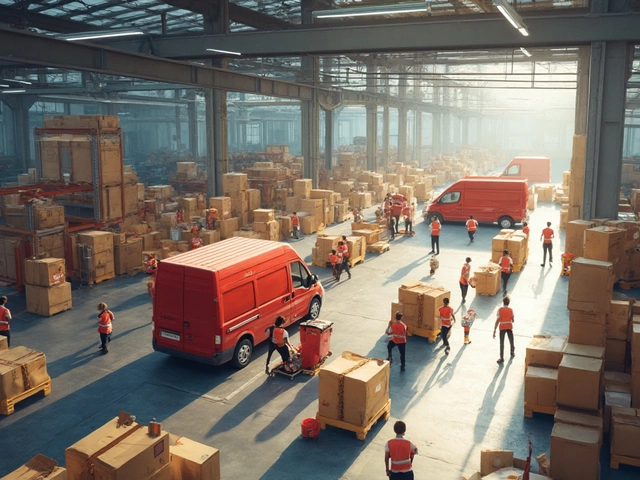Package tracking used to mean checking a UPS code and hoping for the best. But now Amazon’s blue vans seem to be everywhere—has their logistics business really gotten bigger than UPS? That sounds wild, but the numbers might surprise you.
Back in 2015, Amazon handled almost none of its own US deliveries. Fast forward to last year, and research from Pitney Bowes estimated Amazon Logistics delivered more packages in the US than either UPS or FedEx. Kind of mind-blowing, right? Instead of just relying on outside carriers, Amazon built up its own fleet—think planes, vans, warehouses, and a huge army of drivers—with software powering every step.
If you’re thinking about logistics software for your business, this trend matters. Amazon’s logistics all runs on a crazy-advanced system that tracks, sorts, and shuffles packages at lightning speed. UPS, meanwhile, isn’t sitting still—they’ve been around for more than a century and use their own tech to squeeze every bit of efficiency from their routes.
For anyone shipping products, understanding these differences could help you pick the right partner or build smarter into your own operations. There’s a lot more to this story than just delivery trucks—let’s check out the real numbers and what they mean for anyone moving goods in 2025.
- Amazon Logistics: Growth and Scale
- How UPS Built Its Network
- Head-to-Head: Delivery Numbers and Coverage
- The Role of Logistics Software
- Who’s Winning the Race?
- What This Means for Shippers and Businesses
Amazon Logistics: Growth and Scale
Before Amazon Logistics became a delivery powerhouse, Amazon relied on UPS, FedEx, and the U.S. Postal Service to ship its boxes. But seeing how crucial fast, reliable shipping is, Amazon started building its own network around 2014. Since then, the growth has been off the charts.
By mid-2024, Amazon Logistics was handling over 5.9 billion packages a year in the US, according to Pitney Bowes. Just a few years earlier, the number was less than half that. In fact, industry analysts say that in 2023, Amazon delivered more parcels in the US than both FedEx and even UPS. That's a shift you probably never saw coming a decade ago.
So how did they pull this off? Amazon invested billions in their own infrastructure. Here’s what that looks like today:
- Over 100 massive fulfillment centers just in North America
- Hundreds of delivery stations, where packages are sorted for local drop-off
- Roughly 3,000 Amazon-branded delivery trucks and vans in constant motion
- More than 100 cargo planes under the Amazon Air fleet
- A huge network of independent contractors—over 275,000 last-mile delivery drivers just in the US
What’s powering all this growth? Sure, it’s lots of people and vehicles, but the real secret sauce is the Amazon Logistics software. Their tech manages everything from deciding the fastest route to tracking every shoebox or blender as it zips through the network. Small delays or wrong turns get flagged, and the system stays updated down to the minute. No wonder your Prime order shows up almost magically fast.
Here’s a quick look at how Amazon’s package growth stacks up:
| Year | Amazon Packages Delivered (US) | UPS Packages Delivered (US) |
|---|---|---|
| 2019 | 2.5 billion | 4.1 billion |
| 2021 | 4.2 billion | 5.5 billion |
| 2023 | 5.9 billion | 5.3 billion |
Anyone running an online store or working in e-commerce has probably felt the effects. Amazon’s model lets them offer one- or two-day shipping in places where the other carriers have a tougher time keeping up. Their control over every step—from warehouse to door—lets them avoid delays that used to be out of their hands. No wonder competitors are scrambling to adapt.
How UPS Built Its Network
UPS didn’t just pop up overnight. They go way back—founded in 1907, starting with just a handful of messenger boys in Seattle. Back then, packages weren’t whizzing around the country; they were being delivered on foot or by bicycle. UPS leaned into the long game and turned small beginnings into the world’s biggest delivery network.
By the 1970s, UPS started shipping across the United States, and by the late ‘80s, they were global. Today, they cover more than 220 countries and territories—that's nearly every spot you can imagine.
What makes UPS run so smoothly? They put a ton of cash and brains into building sorting centers, owning a fleet of brown delivery trucks, and flying their own cargo planes. If you’ve ever flown through Louisville, Kentucky, you’ve probably seen their Worldport hub—it's gigantic and can process about 416,000 packages every hour.
| UPS Network Stats | 2024 Numbers |
|---|---|
| Employees | Over 500,000 |
| Daily Packages Delivered | About 22 million |
| Delivery Vehicles | Over 125,000 |
| Owned Aircraft | Almost 600 |
| Countries Served | 220+ |
But it’s not just trucks and planes that got them here. UPS has always been quick to use tech—way before it was trendy. Their package tracking system kicked off in the '90s, and they started using routing optimization software called ORION in 2013, which saves millions of gallons of fuel every year.
If you’re a business looking for worldwide coverage, UPS's size and tech are hard to beat. Their network is built for scale, but also for reliability, whether you're shipping sneakers across town or auto parts halfway around the world.
Head-to-Head: Delivery Numbers and Coverage
When you put Amazon Logistics and UPS side by side, the numbers tell a crazy story. Just a few years ago, UPS ruled home delivery. But as of 2024, Amazon claims the top spot in the U.S. for total packages delivered.
Let’s look at straight package counts first. According to Insider Intelligence and Pitney Bowes’ 2023 shipping index:
| Carrier | U.S. Parcels Delivered (2023 estimate) | Year-over-Year Growth |
|---|---|---|
| Amazon Logistics | 5.9 billion | 12% |
| UPS | 5.3 billion | 1% |
| FedEx | 3.1 billion | -2% |
That’s right—Amazon’s delivery arm shipped out more packages than UPS last year, and the gap’s only widening. Amazon’s growth keeps speeding up while UPS plateaus. But before you bet it all on Amazon, remember: UPS is still king internationally. Their global coverage spans over 220 countries, while Amazon is mostly sticking to the U.S., UK, Germany, and a handful more right now.
- Amazon covers more same-day and next-day local deliveries than UPS in most major U.S. cities. If you’re looking for speed inside the U.S., Amazon’s network is hard to beat.
- UPS offers a more robust international network. Need to ship to Brazil, Japan, or South Africa? UPS goes there—Amazon doesn’t (at least, not yet).
- Amazon’s largest hub is in the U.S., with over 110 fulfillment centers, while UPS has about 1,000 facilities and service centers globally.
One thing no other carrier does like Amazon is control the whole journey—from warehouse shelf to the customer’s doorstep, often without any outside help. That lets them move quick, cut costs, and squeeze in more deliveries per day. UPS, on the other hand, mainly does the pick-up-and-drop-off game, working with a wider mix of customers, locations, and international destinations.

The Role of Logistics Software
Everything in the world of package delivery today is built on logistics software. That’s the real engine driving both Amazon Logistics and UPS, and it’s why these companies can move millions of boxes every day across the country—and sometimes overnight. Without solid software, none of this works.
Amazon built its own custom system, and this is a big reason why their network grew so fast. Every order you place on Amazon triggers a chain reaction: their software decides which warehouse should ship it, plots the fastest route, and assigns it to a driver. Everything, down to the last minute, is coordinated by algorithms that help deliver on the "two-day" or "same-day" promises you see at checkout. Their system tracks thousands of delivery vans, tells drivers exactly where to go, and reroutes in real time if something changes. This is what sets Amazon apart—they control the data, the rules, and the speed.
UPS, on the other hand, runs a legendary system called ORION (On-Road Integrated Optimization and Navigation). This tool figures out the most efficient route for each driver, saving time and cutting fuel—UPS claims it’s saved them hundreds of millions of dollars by shaving off just one mile from each driver’s daily route. That’s wild efficiency. But the thing is, their system is built to serve not just one marketplace but all sorts of businesses, big and small.
For anyone shipping products, the power of logistics software really changes the game. Here’s what you get when advanced software is in the mix:
- Faster deliveries: The right package goes out from the best location—less time wasted.
- Real-time tracking: You—and your customers—know exactly where packages are, all the way to the doorstep.
- Smarter inventory: Warehouses know what’s low and what’s moving, so you never run out of stock.
- Fewer mistakes: Algorithms catch errors before they become a headache.
- Cheaper operations: Drivers take efficient routes, warehouses pack smarter, less money gets burned.
Want to step up your own delivery or fulfillment game? It all starts with the right software—and even small businesses can tap into these tools, not just the giants. A lot of what used to be out of reach is now just an app or integration away.
Who’s Winning the Race?
If you’re eyeing the package delivery race in 2025, it’s kind of a wild story. Amazon Logistics and UPS are both massive, but their size and strategy are totally different. The most jaw-dropping stat? According to Insider Intelligence, Amazon delivered about 5.9 billion packages in the US in 2023. UPS moved somewhere around 5.3 billion packages domestically. That means Amazon Logistics now delivers more US packages than UPS—as wild as that sounds.
But package count isn’t the whole story. UPS is still king for global reach, business deliveries, and time-critical shipments. Amazon’s network is built for its own marketplace, with the bulk of deliveries for Prime and Amazon sellers. UPS, meanwhile, serves everyone from e-commerce shops to medical labs to manufacturers.
Check out this simple comparison to get the picture:
| Company | 2023 US Packages Delivered | Global Reach | Main Focus |
|---|---|---|---|
| Amazon Logistics | 5.9 billion | Mostly US + select international | Amazon marketplace |
| UPS | 5.3 billion | 220+ countries | Worldwide businesses |
Where Amazon wins is speed plus volume—especially for Prime customers. Their network is hyper-focused on getting Amazon Logistics orders to your doorstep quickly. UPS is still the go-to for complex, international, or regulated shipments. Their tracking, returns, and guaranteed times are hard to beat for a lot of businesses.
If you’re trying to pick a winner, think about what you need most: fast domestic deliveries for Amazon sales, or dependable service for every country and every shipping scenario. For now, Amazon leads the volume race in the US, but UPS still dominates the global stage.
What This Means for Shippers and Businesses
So, what does this Amazon vs UPS showdown actually mean for your business, whether you’re a small online shop or a warehouse manager at a manufacturer? The shakeup is bigger than just more delivery options showing up on checkout pages. In 2023 alone, Amazon Logistics handled about 5.9 billion parcels in the US, while UPS came in at around 5.3 billion, according to Pitney Bowes.
| Provider | US Parcels Delivered (2023) | Primary Service Focus | Fleet Size (est.) |
|---|---|---|---|
| Amazon Logistics | 5.9 billion | Retail + Marketplace Sellers | ~100,000 vans, 110+ planes |
| UPS | 5.3 billion | B2B, B2C, Global Freight | 125,000+ trucks, 290 aircraft |
This rivalry means more choices, but also more complexity when choosing a shipping partner. Here’s what you need to think about:
- Service Area: UPS still reaches nearly every US address and 220+ countries, while Amazon focuses mostly on their own packages and some select sellers.
- Speed: Amazon’s logistics typically shines on Prime orders and urban deliveries, where they can hit same-day or next-day speeds. UPS tends to be more predictable for ground, air, and international deliveries.
- Technology: Both carriers offer automated tracking and logistics software, but Amazon’s tools are usually only for its own sellers. UPS works with broader e-commerce platforms and offers shipping APIs.
- Pricing: Amazon’s shipping rates can be lower if you’re FBA (Fulfilled by Amazon). UPS often gives volume discounts and has more flexibility for businesses outside the Amazon ecosystem.
If you’re shipping the bulk of your sales through Amazon, sticking with their logistics can make sense—especially with all the built-in tracking and speedy customer service. For businesses needing more control, or shipping big bulky items, dangerous goods, or sending internationally, UPS is often still the safer bet.
The real takeaway? Sellers and shippers who keep an eye on both giants—and tweak their strategy as these networks grow—can grab the best deals and service perks. It’s smart to use analytics tools to track delivery times, costs, and customer satisfaction. If you’re juggling both networks or want to automate label creation, logistics software integrations (like ShipStation, EasyPost, or even custom APIs) can be a game-changer for a smoother workflow.





